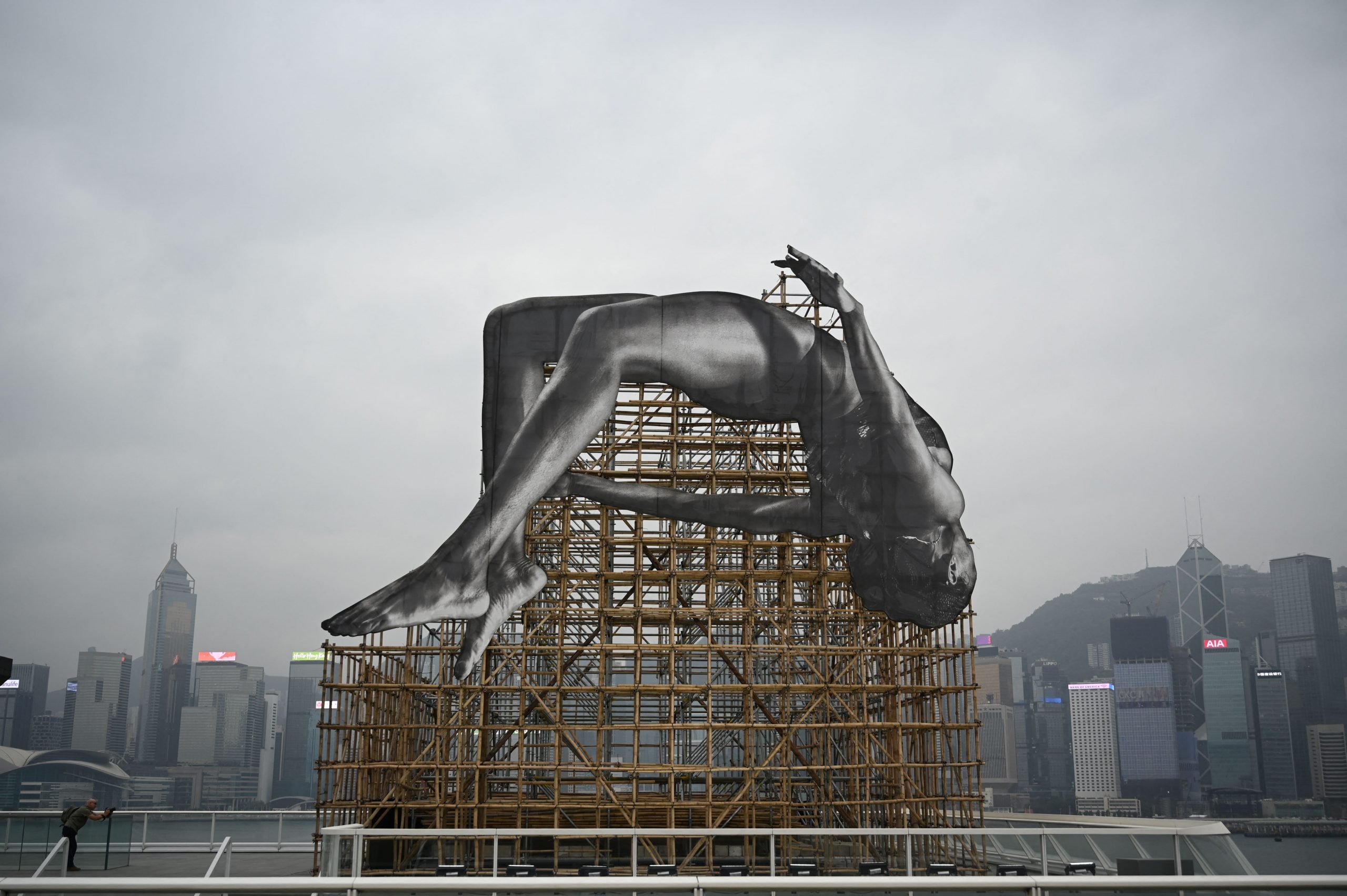
The French artist JR has created a monumental outdoor installation for Hong Kong to celebrate the city’s art month this month. But the installation, which depicts a high jumper, has drawn criticisms from several feng shui consultants and fortune tellers, who argued that the work looks like a person who fell off from a building from afar, and hence projecting a bad omen. Titled Giants: Rising Up, the installation was unveiled this week ahead of next week’s Art Basel Hong Kong, which has its VIP days beginning March 21. Commissioned by the shopping mall Harbour City and on view until April 23 at the Ocean Terminal Deck in Tsim Sha Tsui, Kowloon, the work, which measures nearly 40-feet-tall and 40-feet-wide (12 meters high and 12 meters wide), is the famed artist’s first offering in Asia from his ongoing “Giants” series.
“The gigantic art installation depicts a larger-than-life high jumper floating in mid-air adjacent to Hong Kong’s iconic Victoria Harbour, with her body bending gracefully and her head back facing the fabulous skyline,” the press release wrote.
“The high-jumping athlete appears to jump off the ground and enjoys the sensation of free fall,” the press statement continued, adding that the athlete’s move represented “take off,” referencing to a “Giants” installation on view at the 2016 Rio de Janeiro Olympics. JR also added “a touch of Hong Kong” by fusing the image with a bamboo scaffolding, a construction technique regarded as “safer than steel” that has been listed as the city’s intangible cultural heritage.
JR, GIANTS: Rising Up. Courtesy of Harbour City.
But JR’s artistic creation failed to appeal to some feng shui consultants, as well as practitioners and believers in the traditional art of Chinese metaphysics and divination. “Doesn’t it look like someone who fell off from a building landing on a bamboo scaffolding, and the body is pierced through by the bamboos?” asked Buddhist theorist and feng shui master Po Sin in a recent video on his YouTube channel. Po Sin’s view was echoed by a recent Facebook post penned by feng shui practitioner Steve Lee, who also shared a similar impression of the work. Their views were also echod by some internet users.
Feng shui is understood as the ancient Chinese study of arranging one’s surroundings in order to facilitate the positive flow of energy or bring fortune, and is widely adopted in interior design and architecture in Hong Kong. Some non-believers, however, criticized it as mere superstition. Po Sin, nevertheless, went on saying that although bamboo scaffolding was distinctively from Hong Kong, and it could be aesthetically pleasing, the depiction in this JR work was not appealing.
“You can have people climbing on a bamboo scaffolding, but not having someone landing on it on a person’s back,” the master said, adding that the out-of-context jump looked like the jumper was diving into the sea, which has a bad connotation in the local cultural and lingual context. Artnet News has reached out to Harbour City for comment, but did not hear back by publishing time.
KAWS’s Companion at Victoria Harbor, Hong Kong. Photo: Isaac Lawrence//AFP/Getty Images.
Lee, the feng shui practitioner, also compared the bad omen projected by JR’s new work with that of American artist Kaws’s Kaws:Holiday public installation in Hong Kong that was on view in March 2019. The installation saw the gigantic, crossed-eye inflatable sculpture of Companion lying flat on its back floating on Victoria Harbour, which Lee interpreted as the “fortune basin” of Hong Kong.
“Call me superstitious, but placing a ‘floating dead body’ in the middle of Victoria Harbour, the sight is unbearable,” Lee wrote in a post in March 2019. Lee then followed up with another post in October 2019, when the city was rocked by pro-democracy protests that had tipped off in June, sparked by the anti-extradition law movement.
“The artwork ‘dead body in Victoria Harbour’ was merely a prophecy,” he wrote, predicting that the city will continue to suffer in subsequent years, affecting all local citizens regardless of age and political orientation. Whether or not Kaws’s installation could be read as an omen, in reality, the city was nearly cut off from the rest of the world for almost three years under stringent Covid restrictions. The authorities continue to crackdown political dissents since the implementation of national security law in 2020 and the revival of the use of colonial-era sedition law, which saw hundreds of activists, pro-democracy politicians, and journalists arrested. The city’s stock market index, Hang Seng Index, plunged from its high note at over 30,000 in May 2019 to 14,863 in October 2022, its lowest since 2009.
Is JR’s new artwork really a bad omen? Benson Wong, a former Hong Kong Baptist University political science professor-turned astrologer and psychic, noted that in this case, the meaning of the work is defined by viewers. If the work is associated with negative meanings, the work is seen as “a projection or manifestation of such negativity and unlucky energies,” Wong told Artnet News. “It is a reflection of collective consciousness.”